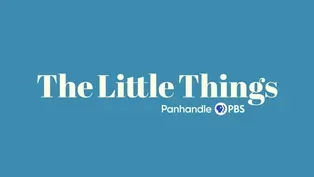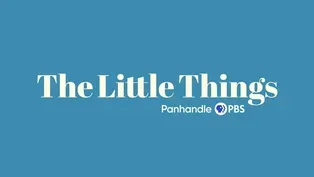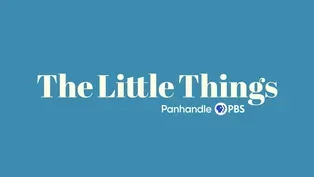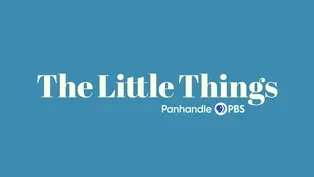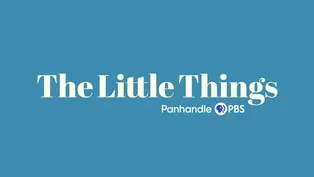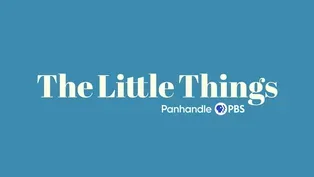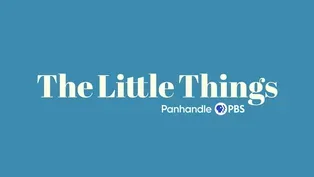The Little Things
Episode 1 – Why & Why Now
9/15/2022 | 26m 59sVideo has Closed Captions
Explore "the little things" you can do to improve your mental health.
The weight of the world can be crushing these days. But the brain can be rewired with "the little things" – simple things you can do to improve your mental health.
Problems with Closed Captions? Closed Captioning Feedback
Problems with Closed Captions? Closed Captioning Feedback
The Little Things is a local public television program presented by Panhandle PBS
The Little Things
Episode 1 – Why & Why Now
9/15/2022 | 26m 59sVideo has Closed Captions
The weight of the world can be crushing these days. But the brain can be rewired with "the little things" – simple things you can do to improve your mental health.
Problems with Closed Captions? Closed Captioning Feedback
How to Watch The Little Things
The Little Things is available to stream on pbs.org and the free PBS App, available on iPhone, Apple TV, Android TV, Android smartphones, Amazon Fire TV, Amazon Fire Tablet, Roku, Samsung Smart TV, and Vizio.
Providing Support for PBS.org
Learn Moreabout PBS online sponsorship- [Narrator] If you are someone you know is in crisis, help is available.
Call or text 988 to be connected to trained counselors from the National Suicide Prevention Lifeline.
Free and confidential support is available 24 hours a day, seven days a week in the United States.
If it is an emergency, please call 911.
For more information visit suicidepreventionlifeline.org.
(gentle music) - What has meditation given you in your life?
- Much more of a sense of who I am, and more grounded, more focused, more aware of what's going on, more aware of my motivations for what I'm doing and why I'm doing it.
Really kind of the ultimate question in Zen is who I am, not biographically, not my name not my job title, but who I am in connection with everything around me really.
- What was it that drew you to it?
- At first, it was kind of selfish reasons.
I saw in particular one person who, I could look at his face and see the common serenity.
And I was like, "I want that.
(gentle music) I want that."
(gentle music) - [Narrator] More people around the globe Googled "how to maintain mental health" in 2021 than ever before.
(gentle music) Between the pandemic, politics, and personal matters, we're stressed out.
The whole planet is stressed out.
We asked local and national experts for their advice and the research behind it.
Breathing intentionally, being mindful, exercise, connection, creativity.
(gentle music) Those aren't just buzzwords, they're science-based strategies to help us build resilience.
(gentle music) Sometimes the little things can make a big impact.
(gentle music) Let's start with a little thing.
You'll see more of these throughout the series.
- One of my favorite meditations is my "red light meditation."
Where when I hit a red light, instead of cursing and using various hand gestures, I just kind of put my hands in my lap, 'cause I'm gonna sit there for the red light no matter what.
I mean I missed it, right?
So I just take three big deep breaths.
(gentle music) And that helps calm me down and all of a sudden it's not this big tragedy that I missed a red light.
- The brain's amazingly pliable, even when you're old like me, it's amazingly pliable.
And so, and what we found is if we stay healthy, physically healthy, then this physical thing here stays healthy too.
(gentle music) - Neuroplasticity is really referring to the ability of our brain to keep growing and making neuronal connections or for our brain cells to be able to talk to each other, and so that we can think and feel and do all the things that we want to do to the best of our ability.
And so there are periods in our lives where our brain is highly neuroplastic.
When we're growing, when we're kiddos and we're learning a lot - Even if a patient is an elderly patient in their 80s, we still know they have 700 neurons a day that are new and are capable of changing.
- Think about grief, when we lose somebody and we're sad, we have to relearn how to live without them in our life, right?
And our brain is trained and it looks for them.
You go into the living room to sit beside your spouse to watch, you know, TV, they're not there.
But your brain knows to look over at that chair where they often are and you see it empty and you're sad.
So your brain has to relearn, and it's harder when you're older.
- Over the course of the pandemic and with all the things that we've dealt with lately, it's interesting to see the size of your amygdala can change.
Your amygdala, we see research that your amygdala can grow when you've been exposed to prolonged stress.
Actually the way we store memories changes when we're under periods of prolonged stress.
So we're more likely to remember negative events, which is fascinating because if you think about it, that makes sense.
Our brain is protecting us.
"Remember all the bad things that happened and maybe they won't happen again."
And so if we think about neuroplasticity as the ability for our brain to change and grow, create new connections, then the positive side of it is that we also can change and grow with intention.
- Even if you have had some experiences during the past that have brought you hard times and discouragement, depression, or things like that, over time with training and mindfulness and behavioral cognitive therapies, a lot of those things can change.
And then you can kind of reprogram your brain to work in a way that benefits you both physically and mentally.
- So if we are exercising, sleeping, eating well, not drinking to excess, avoiding other toxins, then, you know, we're gonna have a plastic brain well into our lives.
We can recover from strokes.
We can recover from brain trauma, and we can recover from depression and psychosis as well, because it actually is physical structures of the brain that heal and begin to function better.
And so that whole area of neuroplasticity, this is an amazing organism, the brain.
(gentle music) - The times now are stressful for me and it bothers my anxiety.
It bothers my depression.
In fact, from March until August, I was having a super tough time.
I think it's just been all of the things going on in the United States, in the world and just all of these - And I don't wanna just say politics but, you know, geopolitical, this, that, everything - it just like came together as a perfect, nasty storm.
And honestly, August is when my doctor started changing things around.
She was like, you know, "You're slipping."
(chuckles) And I was, I was, I was slipping badly.
- Our brains weren't made to hold the pain of the whole world.
They were made kind of evolutionarily to hold the pain of our community.
And with the evolution of social media, and kind of the exponential growth, now, we're having to hold everyone's trauma all the time.
And I think we're just not really wired for that.
- What I think is actually helpful is like helping people figure out where they're at and meeting them right there.
And so if they're not really in a very positive mindset which understandable, I mean, the world is on fire.
So it's hard to kind of find a place where like everything feels good.
I think that feels really reasonable.
And it almost would be completely incoherent to think of someone just being so, so happy across the board.
I mean, certainly there are moments of happiness.
A more effective kind of way to maybe approach positivity is to think about ecstatic temporalities, like these little moments of happiness versus just happiness as a flat like spectrum across the board.
I think that almost no one has those moments or just the life of that.
I think we more realistically have these little moments and it's really about appreciating those and really kind of investing in those moments because that's what will carry you through like the other spaces, the darker moments the more pessimistic moments.
It's having something to hold onto.
(gentle music) - In general, in Amarillo, there's a huge psychiatric need in the community.
The bread and butter kind of things that we see in our clinic are depression, anxiety, bipolar disorder.
And more broadly in the community, of course, we have some of our more serious and persistent mental illness like schizophrenia, and substance use is everywhere.
So alcohol, in Amarillo in particular, methamphetamine use.
We do have an opioid problem here as well.
- Three out of four people are interacting with mental, mental illness and addiction at some point in their life.
If not themselves, a family member, a friend, a colleague, someone they know, someone they've done a project with.
That's a lot of people.
I've suffered with depression myself.
- Understand the prevalence of, you know, people who are having difficult times, stress-related issues, depression, anxiety, realize that you probably know someone who's struggling right now or dealing with it and just coping somehow on a day-to-day basis.
- Going into the pandemic, we were doing a terrible job with mental health, particularly the mental health of young Americans and young Texans.
So before the pandemic, suicide was the second leading cause of death among adolescents and young adults up until you get into your 30s.
So now, you know, two years in, we have baseline rates of depression in the country, more than three times what they were before the pandemic.
And we don't know, those aren't necessarily severe cases of depression, but it's three times what the baseline was.
We think a lot of it's mild to moderate, but it increases everybody's stress.
Rates of anxiety disorders, not just, you know, little bit of worry.
I mean, to worry about a pandemic is a normal reaction but to worry so much that it interferes with your daily functioning, then I think, you know, nowhere clearer than in our emergency rooms, our children's hospitals where we've seen a 50% increase in the number of young people coming in at risk of dying from suicide, particularly girls and young women, but really across the board, not just ideation but like mortality was at the highest rates ever.
- With our students lots of times when they come in, it's because of suicidal thoughts, you know, feeling helpless, feeling hopeless, feeling like they might have made a mistake.
Maybe they shouldn't be in college.
Maybe they're not prepared for college.
So we're just seeing a lot more students.
And it's a little different kind of student.
We've seen more students that are typically those who do well academically, manage stress, can take on a lot.
And it seems like people are very much struggling more than they did before.
And we're looking at about a 60 to 65% increase in the number of people since 2016.
- People who had previously been fairly stable in terms of existing mental illness, anxiety or depression had exacerbations.
All across the board, all across the country, we've seen increases in substance use disorders and overdose deaths with every single substance.
- I think the pandemic has opened it up to where more people are experiencing behavioral health issues.
(gentle music) because their life changed and it changed without anything that they had control over, right?
And so we were all exposed to that and we all became vulnerable together in different ways.
But I think it kind of leveled the playing field for some folks where maybe they didn't really think about their mental health or behavioral health issues.
And then all of a sudden when their life changed, things started happening differently.
Their security got rattled.
- The average time between the onset of symptoms for a diagnosable psychiatric condition and date of treatment is about 10 years.
It's longer for folks with a substance use disorder mixed in with that.
So if folks were on the edge before they were told to isolate, they lost housing, they lost jobs, they lost family members, these huge stressors coming to their lives, it's gonna be a minute before we know like the full impact of that.
And we know that relapse rates have gone up.
We know that it's been really, really, really hard on lots of people.
It's going to be a while before we really fully understand the impact.
(gentle music) - And we've had more and more people reaching out which is actually a really good thing that people are willing to reach out to access care.
But I think the system's a little overwhelmed.
I don't know that we have enough people.
All across the nation there's a psychiatrist shortage.
And in Amarillo in particular, there just aren't enough of us.
The wait lists are pretty long.
(gentle music) - Telemedicine has actually been so good for our area because we don't have enough providers.
I don't know if we'll get enough providers for a long time because actually the whole nation doesn't have enough providers, there's such a shortage - Prior to COVID, I had to turn down probably three to five people a month just because I was overbooked.
Probably during the beginning of the pandemic, it was maybe three to five people a week.
At this point, I'm up to three to five people a day.
and so I'm spending a chunk of my day, every day calling people back saying, "I can't get you in.
I'm really sorry."
And when the question is, "Who can?"
The answer is, "Everybody I know is full."
And so it's prolific at this point.
- How important is self-care?
- It's critical.
I mean, you have to start there.
You have to start with yourself before you can help others.
Like I said earlier, you have to model it.
So you can't do this work without that.
- One of the things I think a lot is that I'm dealing with the most difficult work I've ever done with the least emotional resources I've ever had personally because I'm also living through a pandemic.
(gentle music) - [Narrator] The National Council for Mental Wellbeing reported that 77% of counties in the United States are experiencing a severe shortage of mental health providers.
That includes all 26 counties of the Texas Panhandle.
(gentle music) - Over the last five years, APD has averaged about 3,300 calls where there was a mental health component that we can show.
(gentle music) Whether that's a crisis response or someone calling for services or some sort of referral.
You know, oftentimes we get calls from family saying, "Hey, I have a family member, I have a friend, I think they need some help.
Can you check on them?
Can you help me?"
'Cause, you know, people, people don't know who to turn to a lot.
In 2020, there was about a 28% increase in those crisis type of calls and contacts.
- I am the team lead for the intercept program at Texas Panhandle Centers.
We are a team of mental health professionals and we co-respond with the Amarillo Police Department's Crisis Intervention Team to mental health related 911 calls.
So we spend about 40 hours a week in the police car with a crisis intervention officer and then together as a team, we decide what we need to do.
So sometimes that will involve taking somebody to the hospital for treatment.
- I do mental health hearings for the entire Panhandle, except for Randall County.
We have several a week, sometimes 20, sometimes 25.
So if the person is brought into The Pavilion, they they stay there under the doctor's orders.
And then they send us the paperwork, my office gets the paperwork.
I do the final hearing.
And I decide whether or not they go to the state hospital or they stay at The Pavilion or whether they go home.
- Ultimately, our goal is to prevent people from having to go to the hospital or even to jail.
- Jail diversion has become more of a conversation in the last probably four to five years that, you know, the statistics show that there are a lot of mentally ill folks that would be better suited by receiving services versus being incarcerated for what's often, you know, petty crimes - They don't belong in jail.
They just do not belong in jail because they're not criminals.
They are not.
They are sick.
They are sick individuals and they don't even know they're breaking the law.
I mean, we're talking trespassing.
They don't belong in jail.
They belong in a separate facility where they get the help that they need.
- We want people to know that there's a lot of help out there and we're just a small component of all the resources available.
We just usually end up getting called when things have gone, you know, from bad to worse.
- The large scale epidemiological studies that came out in the last 10 years have shown very definitively that half of all mental illnesses, mostly anxiety, depression, begin before age 14.
So by half of the lifetime prevalence, the number of people who are gonna manifest a mental illness, have had its start before age 14, another 25%, by the time your brain's done developing in your mid-20s.
So about 75% of mental illnesses begin before you're fully an adult.
The problem is we don't detect and begin to help people until, on average, 10 years after symptoms begin because that's when we notice it.
That's when things are going bad, and we can't pretend like nothing's wrong anymore.
And we need to do something.
- One out of every five children that age, of that age range, 3 to 19 has some form of mental illness as we define it as some sort of behavioral or emotional issue that keeps them from learning.
- Before the pandemic, children didn't seem to be as stressed as they are now.
So now I'm seeing children, you know, kind of, you know they're at their limit.
And, you know, if they weren't taught how to kind of self regulate before the pandemic, you know everything that's happened in the last year and a half or two years has really just kind of welled up inside of them.
- Let's define social, emotional learning.
What is that?
- To me, the short answer is teaching kids how to be aware of themselves and aware of other people.
So it's how do we get better at interpersonal and how do we get better at intrapersonal?
So another way to say it is how do I make myself more comfortable and connected as a human being?
(gentle music) - Some folks might say the social and emotional part is, you know, something they should get at home, not in the classroom.
- As somebody who was raised in a really dysfunctional home, I would say that the only positive things I did learn was at school and that's before social and emotional was a word.
Now, that's truly just an anecdote about myself, but the thing about social and emotional, we're not talking about specific things that we teach as far as like belief systems.
We're talking about skills that they can learn.
- I think part of it, when it comes to coping skills, I mean I literally have talked to a few students this week who they didn't even know what that term was.
And so even teaching them what coping skills mean and really just that it's ways that we deal with our emotions.
But also teaching them that there are healthy coping skills like the journaling, the exercising, having your alone time, things like that.
But there's also unhealthy coping skills like drugs and alcohol, self harm.
And so teaching them the importance of engaging in those healthy coping skills, 'cause we have to get our emotions out somehow as humans.
And so learning how to do that in a healthy way versus an unhealthy way.
- There's a very startling quote from William Damron who is the dean of education at Stanford, who said the biggest crisis in kids right now is meaninglessness.
So this sense of going to school and realizing school is not a place where they feel comfortable or connected.
I would say I saw the same thing over the 20 plus years I've been doing this.
It's amazing to me how wedded we are to this outcomes-based education, that even before COVID, we were seeing a pretty pernicious, pretty lingering dropout rate.
When you are judging kids strictly on a score, they notice, they see, and many kids look at that and if they can't see themselves being successful, they're gonna go find success somewhere else.
- [Narrator] The Collaborative for Academic, Social and Emotional Learning identifies five objectives of SEL: self-awareness, self-management, social awareness relationship skills, responsible decision making - In a very poor neighborhood in Northern California, we went to a school that is sort of grounded in social, emotional wellness.
So I went to a class of 5-year-olds.
And the first thing I noticed when I walked into that classroom is how joyous this classroom was.
It sort of floated on this little sea of joy and happiness.
And a lot of that was supported by the teacher who was very connected to what was going on for each child in that classroom.
And so I sat down to read with the partners, two little partners who were gonna read.
And one of the young ladies wanted to move ahead in the book and her partner did not want to.
And she said, "I'm getting very frustrated.
I'm gonna take a break."
And she got up from the book and went across the room and got a pinwheel and blew into the pinwheel and then put it back and said, "I feel calmer now."
And came back and started reading.
So that's what I think we mean when we say social and emotional skills, skill building, an awareness of: "This is not working for me right now but there's something I can do to get my head back into this particular game and not cause a fight with you or cause issues with you or my teacher and also calm myself down."
(gentle music) - [Narrator] So now we've discussed the challenges we face.
On the next episodes, we'll show you how to cultivate the little things to improve your own mental health.
(gentle music) - We're understanding more and more about what happens with our body and our brain.
Psychiatric illness is one of the fastest growing fields in medicine.
And we're learning more and more all the time.
That being said, it's still not fully understood.
There's more to know.
(gentle music) - Mental health has to do with mental health, like a mental health disorder, right?
Behavioral health also encompasses substance use.
So those two combined are behavioral health.
And then we look at the physical health indicators, too, that go along with that.
(gentle music) - The first thing that comes to mind is the depiction of a person with a mental illness or mental health issue or diagnosis as being violent, aggressive, out of control.
Those things make good Hollywood, I think, maybe they sell tickets or whatever, but it's not really based completely on reality.
(gentle music) - We've gotta take our blinders off.
We get very focused on self, focused on what we're doing.
"I've got a busy day at work.
This is my schedule, knocking some things off my to-do list."
(gentle music) Let's pull our heads around, look around, ask.
When I ask you how you're doing today, I mean it.
(gentle music)
Video has Closed Captions
Clip: 9/15/2022 | 3m 30s | Take a look at the relationship between police and professional counselors. (3m 30s)
Video has Closed Captions
Clip: 9/15/2022 | 5m 10s | The state of mental health today, both nationally and locally. (5m 10s)
Video has Closed Captions
Clip: 9/15/2022 | 3m 2s | Is it possible to rewire your brain? (3m 2s)
Video has Closed Captions
Clip: 9/15/2022 | 1m 40s | a little thing – A child can use a pinwheel to calm down. (1m 40s)
Video has Closed Captions
Clip: 9/15/2022 | 2m 8s | There is a lack of mental health professionals of all types across the U.S. (2m 8s)
Video has Closed Captions
Clip: 9/15/2022 | 2m 16s | Learn to appreciate and invest in the little moments. (2m 16s)
Video has Closed Captions
Clip: 9/15/2022 | 44s | Try meditating while stopped in traffic. (44s)
Providing Support for PBS.org
Learn Moreabout PBS online sponsorshipSupport for PBS provided by:
The Little Things is a local public television program presented by Panhandle PBS
